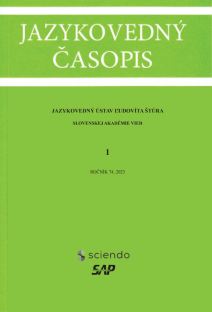Linear Dependency Segments in Foreign Language Acquisition: Syntactic Complexity Analysis in Czech Learners’ Texts
Linear Dependency Segments in Foreign Language Acquisition: Syntactic Complexity Analysis in Czech Learners’ Texts
Author(s): Michaela Nogolová, Michaela Hanušková, Miroslav Kubát, Radek ČechSubject(s): Language and Literature Studies, Theoretical Linguistics, Applied Linguistics, Syntax
Published by: Jazykovedný ústav Ľudovíta Štúra Slovenskej akadémie vied
Keywords: foreign language acquisition; dependency grammar; linear dependency segment; syntactic complexity; Czech language
Summary/Abstract: The paper discusses a new way to measure syntactic complexity in foreign language acquisition. It is based on a recently proposed syntactic unit called linear dependency segment (LDS), the longest possible sequence of words belonging to the same clause where all linear neighbours are also syntactic neighbours. The dataset comprises 5,721 Czech texts from the CzeSL-SGT learner corpus covering five CEFR proficiency levels (A1–C1). The study covers two analyses. First, the development of the average clause length in terms of LDS and the average LDS length in the number of words across the latter language proficiency levels. Second, we consider the differences between Slavic and non-Slavic speakers. The results show an increasing tendency of the average clause length measured in LDS while the average clause length measured in words is decreasing. Results also show statistically significant differences between Slavic and non-Slavic speakers in most cases. Our results indicate that using LDS may be a useful unit of syntactic complexity measure in foreign language acquisition research.
Journal: Jazykovedný časopis
- Issue Year: 74/2023
- Issue No: 1
- Page Range: 193-203
- Page Count: 11
- Language: English

